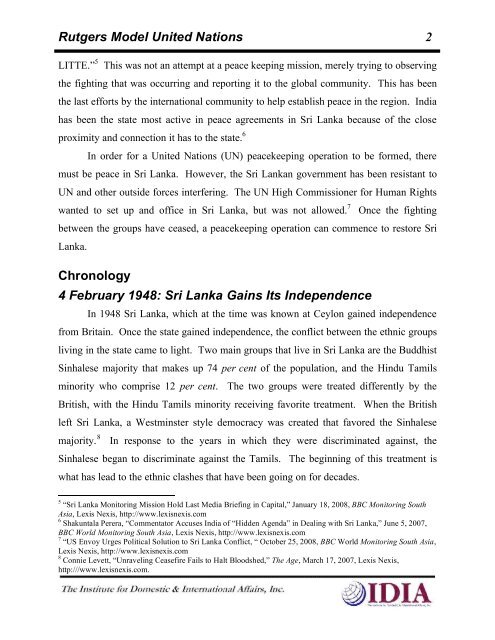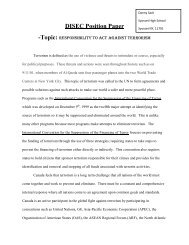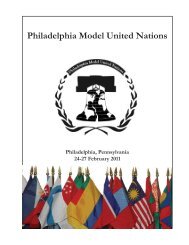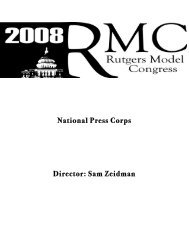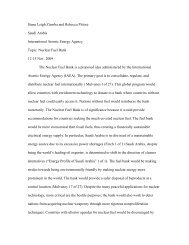You also want an ePaper? Increase the reach of your titles
YUMPU automatically turns print PDFs into web optimized ePapers that Google loves.
<strong>Rutgers</strong> <strong>Model</strong> <strong>United</strong> <strong>Nations</strong> 2<br />
LITTE.” 5 This was not an attempt at a peace keeping mission, merely trying to observing<br />
the fighting that was occurring and reporting it to the global community. This has been<br />
the last efforts by the international community to help establish peace in the region. India<br />
has been the state most active in peace agreements in Sri Lanka because of the close<br />
proximity and connection it has to the state. 6<br />
In order for a <strong>United</strong> <strong>Nations</strong> (UN) peacekeeping operation to be formed, there<br />
must be peace in Sri Lanka. However, the Sri Lankan government has been resistant to<br />
UN and other outside forces interfering. The UN High Commissioner for Human Rights<br />
wanted to set up and office in Sri Lanka, but was not allowed. 7 Once the fighting<br />
between the groups have ceased, a peacekeeping operation can commence to restore Sri<br />
Lanka.<br />
Chronology<br />
4 February 1948: Sri Lanka Gains Its Independence<br />
In 1948 Sri Lanka, which at the time was known at Ceylon gained independence<br />
from Britain. Once the state gained independence, the conflict between the ethnic groups<br />
living in the state came to light. Two main groups that live in Sri Lanka are the Buddhist<br />
Sinhalese majority that makes up 74 per cent of the population, and the Hindu Tamils<br />
minority who comprise 12 per cent. The two groups were treated differently by the<br />
British, with the Hindu Tamils minority receiving favorite treatment. When the British<br />
left Sri Lanka, a Westminster style democracy was created that favored the Sinhalese<br />
majority. 8 In response to the years in which they were discriminated against, the<br />
Sinhalese began to discriminate against the Tamils. The beginning of this treatment is<br />
what has lead to the ethnic clashes that have been going on for decades.<br />
5 “Sri Lanka Monitoring Mission Hold Last Media Briefing in Capital,” January 18, 2008, BBC Monitoring South<br />
Asia, Lexis Nexis, http://www.lexisnexis.com<br />
6 Shakuntala Perera, “Commentator Accuses India of “Hidden Agenda” in Dealing with Sri Lanka,” June 5, 2007,<br />
BBC World Monitoring South Asia, Lexis Nexis, http://www.lexisnexis.com<br />
7 “US Envoy Urges Political Solution to Sri Lanka Conflict, “ October 25, 2008, BBC World Monitoring South Asia,<br />
Lexis Nexis, http://www.lexisnexis.com<br />
8 Connie Levett, “Unraveling Ceasefire Fails to Halt Bloodshed,” The Age, March 17, 2007, Lexis Nexis,<br />
http:///www.lexisnexis.com.


